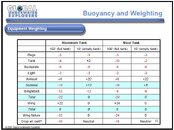On the FL trip, a lot of the dives were in the 80 to 90 foot range. The tank choices were Al80 singles and Al80 doubles. It's hard to do a decent dive and maintain rock bottom on a single Al80 at those depths, which is why doubles were encouraged. It made the logistics of the trip very difficult, because things aren't set up to refill on boats there. Two single, larger tanks would have been perfect, but they just weren't available in the numbers we needed. Bill, Dan and Sandra were, I believe, diving HP100s.
I don't have anything against diving doubles, even just because you like them. I mostly dive mine to stay current on using them so I'm good for the occasional tech dive I do here, and for my cave diving trips. But I like the way they swim -- I just don't like hauling them around very much. My beef with doubles is that I have seen too many people get into them before they had achieved a stable platform in a single tank setup. Doubles, in my experience, make getting that done more difficult, because the inherent top-heaviness of the gear requires careful attention to weighting and is MUCH more unforgiving of anything short of perfect posture in the water. Most of us, even those who had buoyancy and trim pretty much nailed in a single tank, went through a head-up period during the switch -- if you haven't internalized the feeling of horizontal trim before you switch, it's much harder, I think, to find that place and solidify it. I know at least a couple of GUE instructors agree with me on this.






